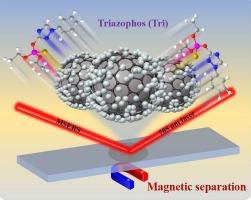Magnetic Fe3O4@rGO-Ag SERS platform for rapid sub-micromolar detection of triazophos in complex food matrices
IF 4.9
2区 化学
Q1 CHEMISTRY, ANALYTICAL
引用次数: 0
Abstract
Triazophos (Tri), a persistent organophosphorus pesticide, poses significant risks on the ecosystems and food safety. Though chromatography-mass spectrometry achieves excellent sensitivity, its cost, training demands and long sample work-up preclude on-site use. Herein, we introduce a magnetic solid-phase micro-extraction SERS platform (Fe₃O₄@rGO-Ag) that couples superparamagnetic isolation (<1 s) with rGO pre-concentration and Ag-nanoparticle plasmonic enhancement. Tri is quantified in 40 min with a limit of detection (LOD) of 0.012 μM (10× lower than direct SERS) and linearity from 1 to 100 μM (R2 = 0.9932). Kinetic modeling and X-ray photoelectron spectroscopy confirm that reversible physisorption dominates Tri enrichment. In complex food matrices (e.g., Brassica campestris L. and mango), the method delivers recoveries of 99–117 % with relative standard deviation (RSD) less than 6.8 % and retains 97 % of the SERS signal in the presence of common interferents. This work bridges the critical gap between laboratory-grade sensitivity and field-deployable practicality in pesticide monitoring. The protocol's magnetic isolation, reversible enrichment mechanism, and user-friendly optical readout make it easier to perform rapid, on-site quantitative screening at farms and markets, thereby reducing the risk of contaminated produce reaching consumers and mitigating ecological exposure to persistent organophosphorus residues.

磁性Fe3O4@rGO-Ag SERS平台快速亚微摩尔检测复杂食品基质中三唑磷
三唑磷(Tri)是一种持久性有机磷农药,对生态系统和食品安全构成重大风险。虽然色谱-质谱法具有优异的灵敏度,但其成本,培训要求和长时间的样品处理妨碍了现场使用。在此,我们引入了一种磁固相微萃取SERS平台(Fe₃O₄@rGO-Ag),该平台将超顺磁隔离(<1 s)与rGO预富集和ag纳米粒子等离子体增强相结合。Tri在40 min内定量,检出限为0.012 μM(比直接SERS低10倍),线性范围为1 ~ 100 μM (R2 = 0.9932)。动力学模型和x射线光电子能谱证实了可逆物理吸附主导了三氮的富集。在复杂的食物基质(如芸苔和芒果)中,该方法的回收率为99 - 117%,相对标准偏差(RSD)小于6.8%,在常见干扰存在的情况下保留了97%的SERS信号。这项工作弥合了实验室级灵敏度和农药监测领域可部署实用性之间的关键差距。该方案的磁隔离、可逆富集机制和用户友好的光学读数使其更容易在农场和市场进行快速、现场定量筛选,从而降低受污染农产品到达消费者的风险,并减轻持久性有机磷残留物的生态暴露。
本文章由计算机程序翻译,如有差异,请以英文原文为准。
求助全文
约1分钟内获得全文
求助全文
来源期刊

Microchemical Journal
化学-分析化学
CiteScore
8.70
自引率
8.30%
发文量
1131
审稿时长
1.9 months
期刊介绍:
The Microchemical Journal is a peer reviewed journal devoted to all aspects and phases of analytical chemistry and chemical analysis. The Microchemical Journal publishes articles which are at the forefront of modern analytical chemistry and cover innovations in the techniques to the finest possible limits. This includes fundamental aspects, instrumentation, new developments, innovative and novel methods and applications including environmental and clinical field.
Traditional classical analytical methods such as spectrophotometry and titrimetry as well as established instrumentation methods such as flame and graphite furnace atomic absorption spectrometry, gas chromatography, and modified glassy or carbon electrode electrochemical methods will be considered, provided they show significant improvements and novelty compared to the established methods.
 求助内容:
求助内容: 应助结果提醒方式:
应助结果提醒方式:


